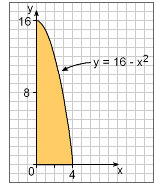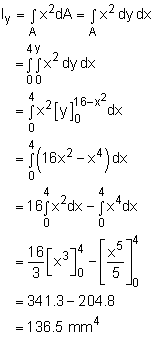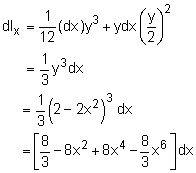| Ch 7. Centroid/Distributed Loads/Inertia | Multimedia Engineering Statics | ||||||
|
Centroid: Line Area Vol |
Centroid: Composite | Distributed Loads | Area Moment of Inertia | ||||
| Area Moment of Inertia | Case Intro | Theory | Case Solution | Example |
| Chapter |
| 1. Basics |
| 2. Vectors |
| 3. Forces |
| 4. Moments |
| 5. Rigid Bodies |
| 6. Structures |
| 7. Centroids/Inertia |
| 8. Internal Loads |
| 9. Friction |
| 10. Work & Energy |
| Appendix |
| Basic Math |
| Units |
| Sections |
| eBooks |
| Dynamics |
| Fluids |
| Math |
| Mechanics |
| Statics |
| Thermodynamics |
| ©Kurt Gramoll |
| STATICS - EXAMPLE |
||
|
|
Example 1 |
|
Find moment of inertia of the shaded area about
|
||
| Solution (a) |
||
Recall, the moment of inertia is the second moment of the area about a given axis or line. For part a) of this problem, the moment of inertia is about the x-axis. The differential element, dA, is usually broken into two parts, dx and dy (dA = dx dy), which makes integration easier. This also requires the integral be split into integration along the x direction (dx) and along the y direction (dy). The order of integration, dx or dy, is optional, but usually there is an easy way, and a more difficult way. |
||
 Cross-section Area |
For this problem, the integration will be done first along the y direction, and then along the x direction. This order is easier since the curve function is given as y is equal to a function of x. The diagram at the left shows the dy going from 0 to the curve, or just y. Thus the limits of integration is 0 to y. The next integration along the x direction goes from 0 to 4. The final integration from is Expanding the bracket by using the formula, | |
| Solution (b) |
||
Similar to the previous solution is part a), the moment of inertia is the second moment of the area about a given axis or line. But in this case, it is about the y-axis, or | ||
 Cross-section Area |
The integral is still split into integration along the x direction (dx) and along the y direction (dy). Again, the integration will be done first along the y direction, and then along the x direction. The diagram at the left shows the dy going from 0 to the curve, or just y. Thus the limits of integration is 0 to y. The next integration along the x direction goes from 0 to 4. The final integration from is | |
| Comment | ||
| The area is more closely distributed about the y-axis than x-axis. Thus, the moment of inertia of the shaded region is less about the y-axis as compared to x-axis. | ||
 |
Example 2 |
|
Determine the moment of inertia of y = 2 - 2x2 about the x axis. Calculate the moment of inertia in two different ways. First, (a) by taking a differential element, having a thickness dx and second, (b) by using a horizontal element with a thickness, dy. |
||
| Solution |
||
 |
a) The area of the differential element parallel to y axis is dA = ydx. The distance from x axis to the center of the element is namedy. y = y/2 Using the parallel axis theorem, the moment of inertia of this element about x axis is For a rectangular shape, I is bh3/12. Substituting Ix, dA, and y gives, Performing the integration, gives, |
|
|
(b) First, the function should be rewritten in terms of y as the independent variable. Due to the x2 term, there is a positive and negative form and it can be expressed as two similar functions mirrored about y axis. The function on the right side of the axis can be expressed as The area of the differential element parallel to x axis is Performing the integration gives, Performing a numerical integration on calculator or by taking t = 2(2 - y) the above integration can be found as, As expected, both methods (a) and (b) provide the same answer. |
|









